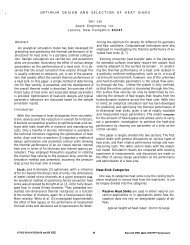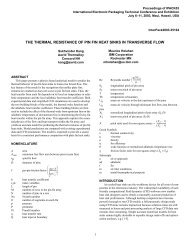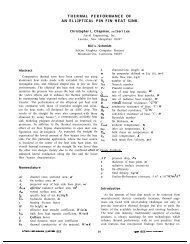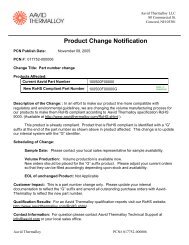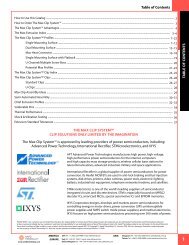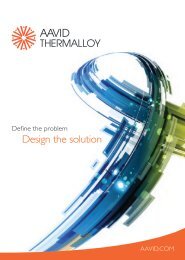Paper - Aavid Thermal Technologies
Paper - Aavid Thermal Technologies
Paper - Aavid Thermal Technologies
You also want an ePaper? Increase the reach of your titles
YUMPU automatically turns print PDFs into web optimized ePapers that Google loves.
ADVANCED COOLING METHODS FOR HIGH POWER DENSITY IN<br />
ELECTRONIC<br />
By Dr. Ing. Cesare CAPRIZ<br />
AAVID THERMALLOY<br />
Director of European Business Development Phone: ++39 051 764011<br />
Via XXV Aprile 32 Fax: ++39 051 764090<br />
40057 Cadriano (BO) – ITALY e-mail: capriz.c@aavid.com<br />
Abstract<br />
The aluminium brazing technology, widely used for heat exchangers in automotive applications, is now<br />
implemented in <strong>Aavid</strong> <strong>Thermal</strong>loy with high volumes production capacity for manufacturing high<br />
efficiency and compact coolers for high power density devices.<br />
Technological, compact and cost effective coolers are required because extruded heatsinks, also if<br />
enhanced with forced ventilation, cannot guarantee the thermal resistance required by the new electronic<br />
components. The traditional heatsink limit is due to the not best conductivity of extruded aluminium and<br />
of the not optimised fin design.<br />
Solutions like bonded fins and folded fins are already in the market with very good results, but they<br />
have already reached the limit of the technology and designers want to eliminate completely the thermal<br />
gap base to fins with a real All-Metal-Joint.<br />
Liquid coolers solve many design problems but are still expensive solutions.<br />
<strong>Aavid</strong> <strong>Thermal</strong>loy presents 5 applications (2 patented) based on aluminium brazing: two in forced<br />
ventilation and three based on liquid cooling that brilliantly joint the low thermal resistance with the<br />
economical advantages of industrialization. Introduced in <strong>Aavid</strong> <strong>Thermal</strong>loy one year ago, the<br />
applications are now already on the market available for industrial mass production.<br />
The presentation is completed with comparative thermal and mechanical performances analysis, based<br />
on Icepak fluodynamic software and laboratory test reports and with economical evaluation charts.<br />
0.0 INTRODUCTION<br />
The power density in electronic advanced power modules and in high-end microprocessors requires more<br />
efficient coolers to minimize the heat spreading issues.<br />
The designers of cooling solutions have a physical limit, due to the Convection Factor.<br />
A very high Convection Factor will bring to small heatsinks with short fins, reducing also the Conduction<br />
thermal resistance.<br />
There is also the technological target to eliminate completely the mechanical and thermal gaps amongst<br />
the heatsink components, that now we have with bonded and mechanically inserted fins solutions.<br />
Manufacturing industrialisation is the key process that makes thermal research available on the market.<br />
<strong>Aavid</strong> <strong>Thermal</strong>loy, after 2 years of intensive research and industrialization efforts, is happy to present the<br />
obtained results.
1.0 BRAZEDGAIN COOLERS<br />
The idea started from Powergain, a <strong>Thermal</strong>loy design of more than 10 years ago, widely used for CPU<br />
cooling in millions of standard units.<br />
Powergain solution is formed by a comb shape extrusion, cut to length and with cross-cut fins, forming a<br />
pin-fin style heatsink; the fan is mounted directly on top of the pin-fins with air blowing against the<br />
heatsink base.<br />
The high air flow and its elevated turbulence provide a very effective convective heat exchange with the<br />
lowest thermal resistance that is possible to achieve for a given extrusion and axial fan.<br />
1.2 CONTROLLED ATMOSPHERE BRAZING: A TURNING POINT<br />
The key point to the manufacturing industrialisation of Powergain idea is the aluminium brazing<br />
technology.<br />
Aluminium brazing process started with dip-salt brazing, a very polluting process, moved to vacuum<br />
brazing, high quality but expensive, and now is available the flux brazing or Controlled Atmosphere<br />
Brazing (CAB), a process with the same quality of vacuum but faster and more flexible.<br />
CAB for aluminium opens the road to flexible heatsink design, eliminating the limits of traditional<br />
extrusion process.<br />
It can be compared to thermal bonding with structural resins, but with the following improvements:<br />
‣ Elimination of the thermal gap; the joint is made of the same aluminium alloy of the extrusions<br />
‣ 100% mechanical reliability of the continuous aluminium metal joint; the mechanical strength of the<br />
joint is equal to the mechanical strength of the components<br />
‣ it is not necessary to insert the fins in a groove to give enough mechanical and thermal continuity; a<br />
simple line contact of the same thickness of the fin is already the optimum<br />
‣ for Liquid Cold Plates it is a simple and perfect sealing<br />
In the following pictures, obtained with a 50x magnification, on the left a bonded fin joint; it has an<br />
average thickness of 0.18 mm with the thermal and mechanical propriety of the filling resin; on the right a<br />
brazed joint: it has a thickness of 0.04 mm with the thermal and mechanical propriety of the alluminium<br />
alloy.
A brazed joint (right) is 1000 times<br />
better than a bonded joint (left) or a<br />
pressed fin.<br />
A brazed fin can be assembled<br />
directly on the base without the<br />
insertion groove.<br />
The overall thermal improvement<br />
over bonded or pressed fins ranges<br />
from 4 to 9 % according to the resin<br />
thickness or the amount of micro air<br />
gaps.<br />
1.3 MANUFACTURING INDUSTRIALISATION OF POWERGAIN IDEA<br />
Using the CAB technology (on the right the photo of<br />
the <strong>Aavid</strong> <strong>Thermal</strong>loy new CAB furnace) and the<br />
Powergain principles <strong>Aavid</strong> <strong>Thermal</strong>loy has developed<br />
a new product line called Brazedgain.<br />
The fins are manufactured starting from aluminium<br />
coils, that are continuously punched with about 10% of<br />
the surface perforated by slots which dimension is<br />
calculated with Icepak.<br />
The fins are automatically cut to the appropriate<br />
length, assembled on the aluminium base and finally<br />
brazed.<br />
For medium-high productions, the fin assembly<br />
process is automated to minimise the production costs.<br />
Above example of Brazegain productions for UPS and Inverters.
Examples of Brazedgain for Traction application.<br />
2.0 BRAZEDFIN COOLERS<br />
The brazing technology is used also to manufacture the new family of high fin ratio heatsinks.<br />
The manufacturing process use the same high conductivity alloy for the base and pure alluminium coils<br />
for the fins. The freedom to reach the best fin pitch, height and thickness configuration allows the<br />
Engineers to optimize the heatsink dimensions, minimising the heat source concentration effect.<br />
The heatsinks can be with partial cover, to allow some air escape (below, left heatsink), or with a<br />
continuous cover to form a complete tunnel (middle and right heatsink).<br />
In case of very high and unbalanced heat source concentration, it is possible to use heat pipe spreaders<br />
embedded in the base (right heatsink).<br />
Dimensions of Brazedgain and Brazedfin can range from 25x25 mm to 650x1200 mm base, while the<br />
maximum height can reach 250 mm, including the base thickness.<br />
3.0 LIQUID COLD PLATES<br />
Currently the most popular Liquid Cold Plates are obtained from a copper or stainless steel tube, bended<br />
with tight curves in order to provide an ample heat exchange surface, then embedded in a groove channel<br />
inside an aluminium plate. (photo on the right) The channel can be extruded or milled in a simple plate.<br />
The peculiar shape with the top of the channel slightly<br />
smaller than the central section is an <strong>Aavid</strong><br />
<strong>Thermal</strong>loy Patent and it is necessary to guarantee a<br />
perfect thermal contact amongst pipe and base and a
long life reliability against thermo-mechanical<br />
stressess.<br />
The thermal contact is enhanced by a thermal resin.<br />
The Liquid Cold Plates thus obtained are not very<br />
expensive and reliable, the tube does not have leackage<br />
problems, but the design is unflexible because it is not<br />
possible to bend the tube with a very small radius; it is<br />
also not possible to split the tube in multiple small<br />
parallel tubes or to provide a sofisticate design.<br />
3.1 MILLED LIQUID COLD PLATES<br />
A very flexible manufacturing method for LCP is milling liquid<br />
channels inside an aluminium or copper plate, then sealing the<br />
channels with a cover, assembled with O-ring and screws (left<br />
photo) or brazed.<br />
Brazing is a faster and highly reliable process.<br />
The LCP can be made of copper, but it is heavy and expensive; and<br />
since the liquid cooling is very efficient and nearly in contact with<br />
the heat source, the thermal advantages of copper over aluminium<br />
are not relevant.<br />
Milled LCP obtained with the brazing process are the best solution<br />
for medium-low production volumes with good thermal<br />
performances. Dimensions can range from 50x50 mm for microprocessor cooling to 650x1200 mm.<br />
<strong>Thermal</strong> resistance can reach the value of 2.5 °C cm 2 / W = 4.4 °C/kW for a Milled LCP 182x310 mm.<br />
4.0 BLISTER LIQUID COLD PLATES<br />
<strong>Aavid</strong> <strong>Thermal</strong>loy has patented a new solution where it is<br />
possible to have a partial flexible design, a fast manufacturing<br />
process and full, long time reliability.<br />
The liquid channels are punched in a thin aluminium cover and<br />
the cover is brazed on a simple thick aluminium plate where<br />
the electronic components are assembled. (on the right the<br />
validation prototype)<br />
This solution can not reach the performances of a Milled LCP<br />
but is efficient and very cost effective. It is the most effective<br />
solution for a given thermal resistance.<br />
It is suggested for standard dimensions or for high production volumes, where the cost of the punching<br />
tool is not relevant.<br />
Standard dimensions range from 120x130 to 182x450 mm<br />
<strong>Thermal</strong> resistance has the value of 3.6 °C cm 2 / W = 8.0 °C/kW for a Blister LCP 182x250 mm.
5.0 MICROCHANNELS LIQUID COLD PLATES<br />
When the application needs the lowest available<br />
thermal resistance, over the smallest surface, the best<br />
choice is a Microchannels LCP.<br />
It is made by a stack of aluminium foils perforated<br />
and assembled in alternate order; the assembly is<br />
brazed to guarantee a perfect thermal contact<br />
amongst the plates and the sealing.<br />
The heat flows from the top surface through the<br />
special designed “heat –pits” while the coolant flows<br />
up-and-down the microchannels, formed by the<br />
alternate layers.<br />
The overall result is a very high exchange surface within short conductive paths.<br />
There are no standard products, because it is a typical customized solution, suitable for high production<br />
volumes. This technology is not used for big LCPs; dimensions are usually below 250 x 300 mm.<br />
The thermal resistance is less than 0.8 °C cm 2 / W = 5.6 °C/kW for a Microchannels LCP 130x102 mm.<br />
6.0 TECHNICAL EVALUATIONS FOR AIR COOLING<br />
To have an accurate comparison among different solutions, we have used the values:<br />
Rth*Cost = thermal resistance times cost to evaluate the economical convenience<br />
Rth*Vol and Rth*Weight = thermal resistance times volume or times weight to evaluate the technical<br />
performance. The lower are those values the better is the solution.<br />
Below is a table comparing traditional axial flow for pressed extruded or sheet fins, bonded fins and<br />
brazed fins, against the Brazedgain solution.<br />
All the heatsinks,<br />
except the first, are<br />
150x160x63 mm.<br />
They have been tested<br />
with the same fan<br />
119x38<br />
Pressed<br />
mm<br />
hollow fins<br />
200x200x84 mm<br />
Max<br />
Base<br />
Temp.<br />
o C<br />
83.7<br />
Max<br />
ΔT<br />
Sink-<br />
Air<br />
o C<br />
38.7<br />
Rth<br />
o C/kW<br />
77.4<br />
Efficiency<br />
%<br />
- 8,2<br />
Fan<br />
flow<br />
rate<br />
(lt/s)<br />
38,1<br />
Rth * Vol<br />
°C dm 3<br />
/ kW<br />
260<br />
Rth *<br />
Weight<br />
°C kg /<br />
kW<br />
302<br />
Pressed<br />
sheet fins<br />
83.8<br />
38.8<br />
77.6<br />
- 8.5<br />
29.4<br />
117<br />
139<br />
Bonded sheet fins<br />
83.1<br />
38.1<br />
76.2<br />
- 6.5<br />
29.4<br />
115<br />
136<br />
Brazed fins<br />
80.74<br />
35.74<br />
71.5<br />
0<br />
29.4<br />
108<br />
128<br />
BRAZEDGAIN<br />
no X-cuts<br />
79.80<br />
34.80<br />
69.6<br />
+ 2.7<br />
30.7<br />
105<br />
124<br />
Standard<br />
BRAZEDGAIN<br />
76.94<br />
31.94<br />
63.9<br />
+ 11.9<br />
31.3<br />
96<br />
114<br />
Advanced<br />
BRAZEDGAIN<br />
76.09<br />
31.09<br />
62.2<br />
+ 15.0<br />
31.5<br />
94<br />
111
Below a graphic comparing different air cooling technologies to dissipate 6 kW originated by 6<br />
IGBT modules with 1 kW/each. Delta T ambient-heatsink = 40 °C<br />
6.1 TECHNICAL EVALUATIONS FOR LIQUID COOLING<br />
Below the same thermal test but with 2 IGBT modules dissipating 3 kW/each. Coolant flow 10 lt/min and<br />
Δ T water-heatsink = 30 °C. Comparison is amongst Blister Liquid Cold Plate; copper tube HiContact<br />
LCP, Milled LCP and MicroChannels LCP of the same dimensions 300x180x15 mm.<br />
For all the LCPs we make a leakage test at 5 bars and a burst test at 9 bars.
7.0 CONCLUSIONS<br />
With the new aluminium brazing technology <strong>Aavid</strong> <strong>Thermal</strong>loy offers to the thermal Engineers wide<br />
design flexibility, either in air cooling and in liquid cooling technology.<br />
There is the opportunity to use less power modules or to get more power from the existing electronic<br />
designs.<br />
The higher efficiency for the same heatsink dimensions allows concentrated design and savings in<br />
connections and in cabinet costs.<br />
The new product lines will give a turn to the power cooling market.



